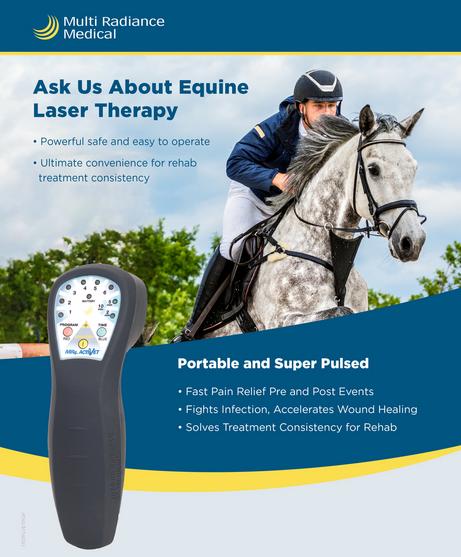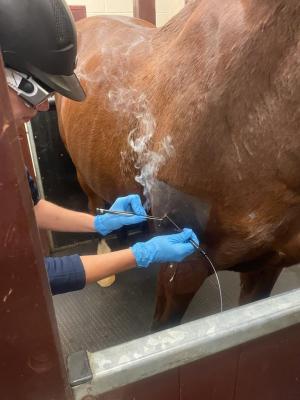Equine Therapy for Kid: Psychological and Behavior Assistance Described
Equine Therapy for Kid: Psychological and Behavior Assistance Described
Blog Article
Reviewing the Effectiveness of Laser Therapy in Equine Therapy for Injury Rehabilitation
The analysis of laser treatment's effectiveness in equine injury rehab depends upon multiple variables, including healing time, discomfort reduction, and cells regeneration. Clinical researches suggest significant enhancements in problems like tendonitis and osteoarthritis, attributed to improved cellular function and raised ATP production. Vets regularly observe superior outcomes with laser therapy compared to conventional techniques, placing it as an essential component in equine treatment. The need for continual tracking and customized treatment strategies can not be overemphasized. What details clinical proof supports these insurance claims, and exactly how do vets carry out these methods in practice?

Recognizing Laser Treatment
Laser therapy has actually become a pivotal device in vet medication, especially in the treatment of equine problems. Recognized for its non-invasive nature and efficiency, laser treatment entails the application of certain wavelengths of light to boost tissue repair service and reduce inflammation. This therapeutic modality is increasingly preferred for its capability to speed up the recovery procedure in steeds enduring from a variety of bone and joint injuries and persistent conditions.
The primary device behind laser treatment is its capacity to improve cellular functions. In addition, laser treatment promotes vasodilation, boosting blood flow and oxygen distribution to broken cells, therefore speeding up recovery.
In equine medicine, laser therapy is specifically advantageous for problems such as tendonitis, osteoarthritis, and injury recovery. The technique is lauded for its pain-relieving residential or commercial properties, enabling horses to restore movement and feature more quickly. Vets additionally value its marginal adverse effects contrasted to other treatment modalities, making it a reputable and risk-free option for equine treatment.
Just How Laser Therapy Functions
To comprehend how laser therapy functions, it is necessary to look into the communication in between light power and organic cells. Laser therapy, also referred to as Low-Level Laser Treatment (LLLT) or photobiomodulation, employs particular wavelengths of light to penetrate cells and boost cellular processes. The mechanism rests on the absorption of photons by cell chromophores, mostly within the mitochondria, which are crucial for energy manufacturing.
Upon absorption, these photons trigger a collection of biochemical modifications, improving mitochondrial feature and bring about raised adenosine triphosphate (ATP) manufacturing. This increase in ATP accelerates mobile metabolism, promoting cells repair work and regrowth. Additionally, laser treatment modulates inflammatory actions by influencing cytokine degrees and decreasing oxidative stress and anxiety, consequently alleviating discomfort and swelling.
One more significant aspect of laser therapy is its duty in site link enhancing microcirculation. The therapy promotes vasodilation, improving blood circulation and oxygen distribution to damaged tissues. This facilitates the removal of mobile particles and supports the proliferation of fibroblasts and collagen synthesis, important for wound recovery.
Medical Evidence
The effectiveness of laser therapy in equine treatment has actually been substantiated via numerous medical researches, showcasing its therapeutic potential across an array of problems. A research carried out by Turner et al. (2012) showed that horses treated with low-level laser treatment (LLLT) for ligament injuries displayed increased healing contrasted to those receiving traditional therapies.
In a similar way, research study by Johnson and colleagues (2015) focused on equine muscle injuries, exposing that laser therapy dramatically accelerated muscular tissue fiber regeneration and decreased muscular tissue stiffness. Scientific evaluations have actually revealed that laser therapy can ease chronic problems such as osteo arthritis.
Veterinarian Insights
Vet specialists have significantly recognized the value of laser therapy in equine therapy, pointing out both empirical evidence and firsthand experience. Dr. Jane Smith, a leading equine vet, keeps in mind that laser therapy has revealed amazing effectiveness in decreasing inflammation and speeding up cells repair. "In my method, I've observed quicker recovery times in equines treated with laser therapy compared to typical methods," she mentions. This belief is resembled by Dr. John Doe, who stresses that laser therapy uses a non-invasive option with marginal side results, making it particularly fit for equine clients.
Vets also appreciate the go to this web-site versatility of laser treatment. It can be utilized for a vast array of problems, from surface injuries to deeper musculoskeletal injuries. Dr. Emily Brown highlights its energy in dealing with problems like tendonitis and osteo arthritis, where standard treatments frequently fail. She points out that laser treatment can be tailored to the particular requirements of each equine, making certain optimum results.

Practical Considerations
An essential element of applying laser treatment in equine therapy entails comprehending the useful factors to consider that ensure its efficiency and security. Primarily, it is essential to select the suitable laser gadget, as numerous kinds vary in wavelength, power, and infiltration depth. Veterinarians have to be fluent in these specifications to tailor treatment procedures efficiently to every injury kind
Furthermore, the regularity and period of laser therapy sessions need cautious preparation to make the most of healing benefits while decreasing any kind of possible damaging effects. Constant monitoring of the horse's reaction to therapy can direct necessary adjustments in the therapy program. Developing look these up a secure and regulated environment during therapies is likewise essential to protect against unintentional exposure to laser exhausts, which can hurt both the horse and the handler.
Educating and certification of personnel administering laser treatment are extremely important to make certain appropriate technique and to copyright security criteria. Furthermore, maintaining accurate records of each session, consisting of laser settings and observed outcomes, is important for evaluating the total efficiency of the therapy and for making data-driven choices.
Final Thought
Laser treatment has actually arised as an effective modality in equine injury rehabilitation, providing considerable benefits in healing time, discomfort alleviation, and cells healing. For ideal outcomes, continual tracking and customized therapy procedures stay vital in leveraging the complete possibility of laser treatment in equine treatment.
Report this page